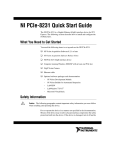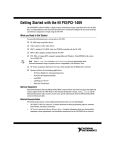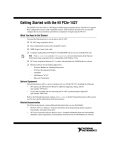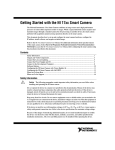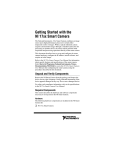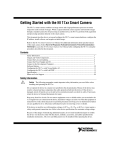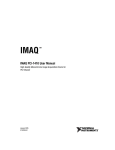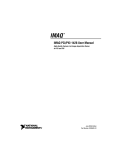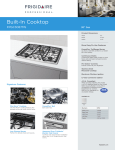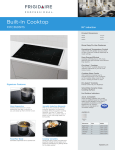Download National Instruments 8252 User's Manual
Transcript
NI PCI-8252 Quick Start Guide The NI PCI-8252 is a highly flexible IEEE 1394a interface device for PCI. The following sections describe how to get started using the NI PCI-8252. Installing the NI PCI-8252 The following section contains a list of necessary and optional items for acquiring images with the NI PCI-8252. This section also explains how to unpack, configure, and install the NI PCI-8252. What You Need to Get Started You need the following items to set up and use the NI PCI-8252: ❑ NI-IMAQ for IEEE 1394 Cameras Software Installation Guide ❑ NI-IMAQ for IEEE 1394 Cameras and documentation Note PDFs of the NI-IMAQ for IEEE 1394 Cameras documentation are installed on your computer at <NI-IMAQ for IEEE 1394>/docs where <NI-IMAQ for IEEE 1394> is the location to which NI-IMAQ for IEEE 1394 Cameras is installed. ❑ Computer with at least one PCI slot running Windows 2000/XP ❑ IEEE 1394 Camera ❑ Optional software packages and documentation: – IMAQ Vision for LabVIEW, LabWindows™/CVI™, or Measurement Studio (Visual Basic) – Vision Builder for Automated Inspection – LabVIEW – LabWindows/CVI – Measurement Studio ❑ IEEE 1394 cable Safety Information Caution The following paragraphs contain important safety information you must follow when installing and operating the device. Do not operate the device in a manner not specified in the documentation. Misuse of the device may result in a hazard and may compromise the safety protection built into the device. If the device is damaged, turn it off and do not use it until service-trained personnel can check its safety. If necessary, return the device to National Instruments for repair. Keep away from live circuits. Do not remove equipment covers or shields unless you are trained to do so. If signal wires are connected to the device, hazardous voltages can exist even when the equipment is turned off. To avoid a shock hazard, do not perform procedures involving cover or shield removal unless you are qualified to do so. Disconnect all field power prior to removing covers or shields. If the device is rated for use with hazardous voltages (>30 Vrms, 42.4 Vpk, or 60 Vdc), it may require a safety earth-ground connection wire. Refer to the device specifications for maximum voltage ratings. Because of the danger of introducing additional hazards, do not install unauthorized parts or modify the device. Use the device only with the chassis, modules, accessories, and cables specified in the installation instructions. All covers and filler panels must be installed while operating the device. Do not operate the device in an explosive atmosphere or where flammable gases or fumes may be present. Operate the device only at or below the pollution degree stated in the specifications. Pollution consists of any foreign matter—solid, liquid, or gas—that may reduce dielectric strength or surface resistivity. The following is a description of pollution degrees. • Pollution Degree 1—No pollution or only dry, nonconductive pollution occurs. The pollution has no effect. • Pollution Degree 2—Normally only nonconductive pollution occurs. Occasionally, nonconductive pollution becomes conductive because of condensation. • Pollution Degree 3—Conductive pollution or dry, nonconductive pollution occurs. Nonconductive pollution becomes conductive because of condensation. Clean the device and accessories by brushing off light dust with a soft, nonmetallic brush. Remove other contaminants with a stiff, nonmetallic brush. The unit must be completely dry and free from contaminants before returning it to service. NI PCI-8252 Quick Start Guide 2 ni.com You must insulate signal connections for the maximum voltage for which the device is rated. Do not exceed the maximum ratings for the device. Remove power from signal lines before connection to or disconnection from the device. Caution National Instruments measurement products may be classified as either Measurement Category I or II. Operate products at or below the Measurement Category level specified in the hardware specifications. Measurement Category1: Measurement circuits are subjected to working voltages2 and transient stresses (overvoltage) from the circuit to which they are connected during measurement or test. Measurement Category establishes standardized impulse withstand voltage levels that commonly occur in electrical distribution systems. The following is a description of Measurement (Installation3) Categories: 1 2 3 4 • Measurement Category I is for measurements performed on circuits not directly connected to the electrical distribution system referred to as MAINS4 voltage. This category is for measurements of voltages from specially protected secondary circuits. Such voltage measurements include signal levels, special equipment, limited-energy parts of equipment, circuits powered by regulated low-voltage sources, and electronics. • Measurement Category II is for measurements performed on circuits directly connected to the electrical distribution system. This category refers to local-level electrical distribution, such as that provided by a standard wall outlet (e.g., 115 V for U.S. or 230 V for Europe). Examples of Measurement Category II are measurements performed on household appliances, portable tools, and similar products. • Measurement Category III is for measurements performed in the building installation at the distribution level. This category refers to measurements on hard-wired equipment such as equipment in fixed installations, distribution boards, and circuit breakers. Other examples are wiring, including cables, bus-bars, junction boxes, switches, socket-outlets in the fixed installation, and stationary motors with permanent connections to fixed installations. Measurement Categories as defined in electrical safety standard IEC 61010-1. Working voltage is the highest rms value of an AC or DC voltage that can occur across any particular insulation. Measurement Category is also referred to as Installation Category. MAINS is defined as the (hazardous live) electrical supply system to which equipment is designed to be connected for the purpose of powering the equipment. Suitably rated measuring circuits may be connected to the MAINS for measuring purposes. © National Instruments Corporation 3 NI PCI-8252 Quick Start Guide • Measurement Category IV is for measurements performed at the primary electrical supply installation (<1,000 V). Examples include electricity meters and measurements on primary overcurrent protection devices and on ripple control units. Unpacking The NI PCI-8252 ships in an antistatic package to prevent electrostatic discharge from damaging device components. To avoid such damage in handling the device, take the following precautions: • Ground yourself via a grounding strap or by holding a grounded object, such as the computer chassis. • Touch the antistatic package to a metal part of the computer chassis before removing the device from the package. Caution Never touch the exposed pins of connectors. Remove the device from the package and inspect it for loose components or any other signs of damage. Notify National Instruments if the device appears damaged in any way. Do not install a damaged device in the computer. Store the NI PCI-8252 in the antistatic package when not in use. Installation The following instructions are for general installation. Refer to the documentation provided by your computer manufacturer for specific instructions and warnings. Refer to the Specifications section for a list of the typical power requirements for the device. 1. Install the NI-IMAQ for IEEE 1394 Cameras driver software before installing the NI PCI-8252 device. For information about how to install NI-IMAQ for IEEE 1394 Cameras, refer to the NI-IMAQ for IEEE 1394 Cameras Software Installation Guide. Note 2. Power off and unplug the computer. Caution To protect yourself and the computer from electrical hazards, the computer must remain unplugged until the installation is complete. NI PCI-8252 Quick Start Guide 3. Remove the computer cover to expose access to the expansion slots. 4. Choose an unused PCI slot, and remove the corresponding expansion slot cover on the back panel of the computer. 4 ni.com 5. Touch a metal part on the computer case to discharge any static electricity that might be on your clothes or body before handling the NI PCI-8252. Static electricity can damage the device. 6. Remove the NI PCI-8252 from the antistatic package and gently rock the NI PCI-8252 into the slot. The connection may be tight, but do not force the device into place. Check that the bracket of the NI PCI-8252 lines up with the hole in the back panel rail of the computer chassis. Note 7. Unless your computer secures expansion devices in a different manner, screw the mounting bracket of the device to the back panel rail of the computer. 8. Replace the cover. 9. Plug in and power on the computer. Your NI PCI-8252 is now installed. Configuring the NI PCI-8252 After you have installed the NI PCI-8252 and powered on your computer, Windows will recognize the device and assign resources to it. Use Measurement & Automation Explorer (MAX), the National Instruments configuration utility, to configure the IEEE 1394 camera connected to the NI PCI-8252 for acquisition. You must install NI-IMAQ for IEEE 1394 Cameras 2.0.1 or later before configuring your camera in MAX. Refer to the NI-IMAQ for IEEE 1394 Cameras Software Installation Guide for more information about how to configure your camera. Note Specifications These specifications are typical at 25 °C, unless otherwise stated. Caution Misuse of this equipment may impair the protection features included. Physical Dimensions PCI ......................................................... 6.40 × 12.16 cm (2.52 × 4.79 in.) © National Instruments Corporation 5 NI PCI-8252 Quick Start Guide Connector 1394 ........................................................Female, 6 pin (3) PCI ..........................................................32-bit, Universal Signaling PCI Vio ....................................................Universal, 33 MHz 1394 ........................................................IEEE 1394a-1995 S100, S200, S400 transfer rates, OHCI v1.1 software interface. Actual 1394 transfer rates are system dependent. Power Consumption Typical ....................................................0 mA at 5 V = 0 mW 0 mA at 3.3 V = 0 mW 40 mA at 12 V = 480 mW (max) Bus Power 1394 ........................................................12 V ±10%, 12 W total, up to 9.6 W/port with ATX power connected Operating Environment The NI PCI-8254 device is intended for indoor use only. Ambient temperature range ....................0 °C to 55 °C Operating relative humidity....................20% to 80%, noncondensing Altitude ...................................................2,000 m (at 25 °C ambient temperature) Pollution Degree .....................................2 Measurement Category...........................I Caution Do not use the NI PCI-8252 for connection to signals within Measurement Categories II, III, or IV. NI PCI-8252 Quick Start Guide 6 ni.com Storage Environment Ambient temperature range.................... –20 °C to 60 °C Storage relative humidity ....................... 20% to 95%, noncondensing Safety This product is designed to meet the requirements of the following standards of safety for electrical equipment for measurement, control, and laboratory use: • IEC 61010-1, EN 61010-1 • UL 61010-1 • CAN/CSA-C22.2 No. 61010-1 Note For UL and other safety certifications, refer to the product label, or visit ni.com/certification, search by model number or product line, and click the appropriate link in the Certification column. Electromagnetic Compatibility Emissions ............................................... EN 55011 Class A at 10 m FCC Part 15A above 1 GHz Immunity................................................ EN 61326:1997 + A2:2001, Table 1 CE, C-Tick, and FCC Part 15 (Class A) Compliant Note For EMC compliance, operate this device with shielded cabling. CE Compliance This product meets the essential requirements of applicable European Directives, as amended for CE Marking, as follows: Low-Voltage Directive (safety) ............. 73/23/EEC Electromagnetic Compatibility Directive (EMC) .................................... 89/336/EEC Refer to the Declaration of Conformity (DoC) for this product for any additional regulatory compliance information. To obtain the DoC for this product, visit ni.com/certification, search by model number or product line, and click the appropriate link in the Certification column. Note © National Instruments Corporation 7 NI PCI-8252 Quick Start Guide Where to Go for Support The National Instruments Web site is your complete resource for technical support. At ni.com/support you have access to everything from troubleshooting and application development self-help resources to email and phone assistance from NI Application Engineers. A Declaration of Conformity (DoC) is our claim of compliance with the Council of the European Communities using the manufacturer’s declaration of conformity. This system affords the user protection for electronic compatibility (EMC) and product safety. You can obtain the DoC for your product by visiting ni.com/certification. If your product supports calibration, you can obtain the calibration certificate for your product at ni.com/calibration. National Instruments corporate headquarters is located at 11500 North Mopac Expressway, Austin, Texas, 78759-3504. National Instruments also has offices located around the world to help address your support needs. For telephone support in the United States, create your service request at ni.com/support and follow the calling instructions or dial 512 795 8248. For telephone support outside the United States, contact your local branch office: Australia 1800 300 800, Austria 43 0 662 45 79 90 0, Belgium 32 0 2 757 00 20, Brazil 55 11 3262 3599, Canada 800 433 3488, China 86 21 6555 7838, Czech Republic 420 224 235 774, Denmark 45 45 76 26 00, Finland 385 0 9 725 725 11, France 33 0 1 48 14 24 24, Germany 49 0 89 741 31 30, India 91 80 51190000, Israel 972 0 3 6393737, Italy 39 02 413091, Japan 81 3 5472 2970, Korea 82 02 3451 3400, Lebanon 961 0 1 33 28 28, Malaysia 1800 887710, Mexico 01 800 010 0793, Netherlands 31 0 348 433 466, New Zealand 0800 553 322, Norway 47 0 66 90 76 60, Poland 48 22 3390150, Portugal 351 210 311 210, Russia 7 095 783 68 51, Singapore 1800 226 5886, Slovenia 386 3 425 4200, South Africa 27 0 11 805 8197, Spain 34 91 640 0085, Sweden 46 0 8 587 895 00, Switzerland 41 56 200 51 51, Taiwan 886 02 2377 2222, Thailand 662 278 6777, United Kingdom 44 0 1635 523545 National Instruments, NI, ni.com, and LabVIEW are trademarks of National Instruments Corporation. Refer to the Terms of Use section on ni.com/legal for more information about National Instruments trademarks. Other product and company names mentioned herein are trademarks or trade names of their respective companies. For patents covering National Instruments products, refer to the appropriate location: Help»Patents in your software, the patents.txt file on your CD, or ni.com/patents. © 2005 National Instruments Corporation. All rights reserved. 374130A-01 Jun05








